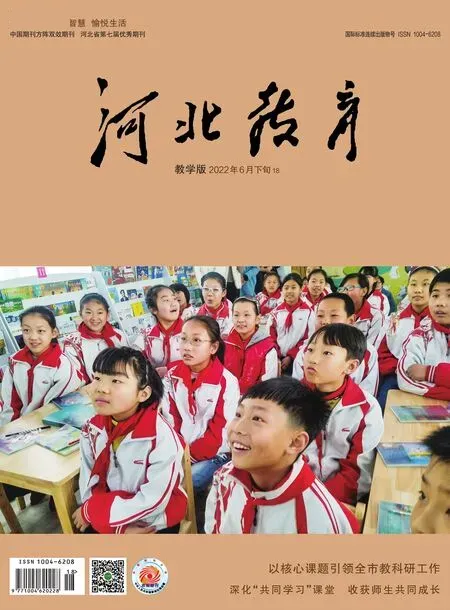小学英语读写教学中的问题与对策
○夏秀琳
读和写作为英语“听、说、读、看、写”五会技能的高阶体现,在小学阶段具有举足轻重的作用。《义务教育英语课程标准(2022年版)》二级学业质量标准关于“读”和“写”是这样描述的:能够借助图片、上下文线索尝试推测语篇中生词的含义;在阅读相关主题的语篇材料时,能梳理人物、场景、情节等信息,独立思考,提出个人见解;能围绕相关主题与他人交流,表达自己的情感、态度和观点,基本达到交际的目的;能用简单的句子描述与中外文化有关的具体现象和事物,语句基本通顺;能运用所学词句讲述简单的小故事,表意基本清楚;进行书面表达时,能正确使用大小写字母、标点符号,拼写基本正确等。
“双减”政策下,要想达到以上读写目标,需要教师依托教材文本,采用科学方法,实施有效策略,激发学生读写兴趣的同时,让学生稳步提高读写能力。本文将结合人教版小学英语高年级下册教材的读写板块,针对当前读写课存在的导入无趣味、阅读质量不达标、指导不到位、策略有缺失等问题,分析读写教学中存在的典型问题,并探讨其解决方案。
【教学回放】
教 学内 容:Whose dog is it?B Read and write读前导入环节
T:(出示课本插图)Look at the pictures and say.
S1:The dog is climbing.
S2:The rabbits are jumping…
T:Right!What are birds doing?
S3:They are flying.
T:Look!I’m flying like a bird.Can you?
Ss:Yes.(学生边说边做。)
T:Good job!Can Robin fly like a bird?Please open your books.Let’s readRobin at the zoo.
【诊断分析】
片段中,教师运用看图说话的方式引入读写课教学,并用边说边做的形式,提前渗透了将要阅读的文本主句I’m doing like a...并以此来引入主话题。看似一切行云流水,直奔主题,但却忽视了一点,就是趣味的重要性。首先,教材原图的呈现缺少新鲜感;其次,大多采用了一问一答的方式,单一乏味;最后,教师直接抛出主题,缺少深层引导。
【教学重构】
T:(播放视频)Let’s sing a songWalking,Walking,okay?
Ss:OK!(学生边做动作边跟唱。)
T:(画面停在下图三个小动物上,教师做相应的动作。)It’s a lovely song.Look!I’m looking at a pig.I’m walking like a pig.What about you?

S1:I’m looking at a rabbit.I’m walking like a rabbit.
S2:I’m looking at a cat.I’m walking like a cat.
T:No,no,no.We are looking at three children.They’re walking like animals.They love animals.Do you love animals?
Ss:Yes!
T:Robin loves,too.So can you guess where Robin is?
Ss:Zoo!
T:(板书课题)Right!Robin at the zoo.
减负不减趣。重构片段中,教师利用与本节课重点词句相关的歌曲和学生一起边唱边做动作,在引导中渗透爱护动物主题,从而使学生轻松进入文本的学习。
【教学回放】
教学内容:How tall are you?B Read and write读中解文环节
T:Wu Yifan has a story to tell Robin.Who is in the story?What are they doing?Please read and answer.(学生自读故事后)OK.Who is in the story?
S1:Little Duck and Old Tree.
T:Do you agree?
Ss:Yes.
T:What are they doing?
……
T:What is Little Duck doing?
S2:He is watching the sun go down.
T:What is Old Tree doing?Let’s listen and repeat.
【诊断分析】
教师的问题零散,没有一定的层次性、指向性和目的性,师不追问“why”,生不思考“reason”,学生只能照本宣科式地进行作答,缺少对文本故事的整体理解和深层思考,不利于学生概括、推理等能力以及批判性思维的培养。此外,阅读课一没有扎实读,二无阅读策略指导,学生无法掌握读写技巧。
【教学重构】
T:Spring is so beautiful.Wu Yifan and his family are going on a trip to the countryside.Wu Yifan has a story to tell Robin.Who is in the story?Read quickly and answer.Begin!(PPT出现10秒倒计时,时间到。)
Ss:Little Duck and Old Tree.

T:Right!Now let’s read again and try to finish“Read and circle”of Page 9.Circle the new words and try to understand them.(教师引导学生根据上下文猜测词意,鼓励学生运用自然拼读法读出生词。)Now who’d like to try?No.1.
S1:I choose A.Little duck’s shadow.
T:Why?
S2:Because Little Duck finds his shadow’s change.
T:Do you agree,class?
Ss:Yes!
T:You’re so smart.Please write down the title.Pay attention to the rules and your handwriting.
(教师巡回指导、纠正、强调书写规则,优秀作品进行展示。)
T:Read the story again and finish the dialogue.
(引导学生运用找关键词句、联系上下文分析等阅读策略进行阅读理解。)
……
本环节中教师在学生读文理解过程中适时渗透阅读策略,引导学生自己理解生词,指导学生关注书写,准确高效完成阅读任务;听音模仿中,教师提醒学生认真听、注意原声语音语调的同时,养成做听读标记的好习惯,学生的“听”不再流于形式,学生的“读”才能保质保量。
【教学回放】
教学内容:Where did you go?B Read and write读后写作环节
T:Wu Yifan’s family had a bad but also good day.Did you have a day like that?
Ss:Yes!
T:Well,talk about it in your group.
(学生分组讨论。)
T:Who’d like to share your bad but good day?
S1:I had a bad but good day.Yesterday I fell off my bike and broke my leg.I stayed at home all day.But…
T:Well done!Now turn to Page 29.Let’s try to write.You can write it after class.
【诊断分析】
上述教学片段中,教师按部就班,先议后说,说后再写。但由于说前任务布置不够具体,目标不够明确,学生在小组研讨时缺少抓手,行进缓慢,尤其对于基础不牢、缺少自信的学生来说,更加难于开口,这样就导致写作环节时间紧张,课上不足只能课下完成了。
【教学重构】
T:Did you have a bad but also good day?
Ss:Yes!
T:Remember that day and try to write it like this.(出示PPT作文模板)Please read by yourselves first.What do you find?

S1:It’s a diary.
S2:Date is on the right of the top.
T:How to write the date in English?
……
T:You’re so great.Okay,now let’s write.
本片段中,教师紧跟上一环节进行文章精简仿写的解读,先把需要注意的事项通过学生观察、教师引导、师生交流的方式理顺;然后趁热打铁,学生课上现场仿写,教师随即当堂指导,大大提高了学生写的质量。

